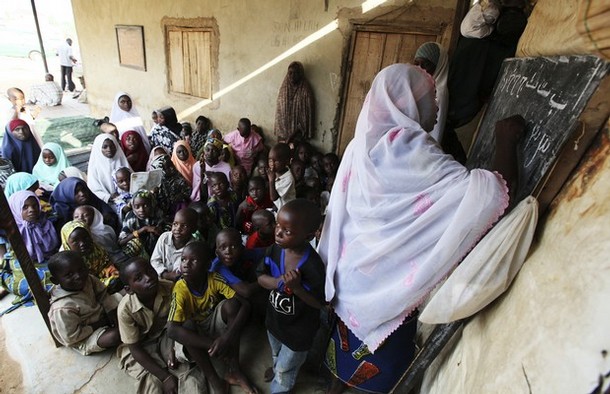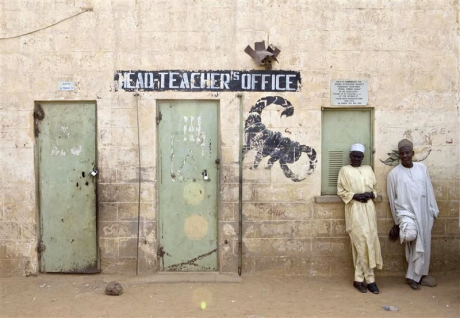By Alex Thurston
This is the fourth post in a series on Islamic education in Northern Nigeria. The first post gave an overview of the series, the second discussed Qur’anic schools, and the third talked about “traditional” advanced Islamic education, noting that traditions change over time.
This post examines “Islamiyya” schools, a format that combines elements of the traditional curriculum with educational models inspired by Western and Arab models. That there has been outside influence on the Islamiyya movement does not mean that Islamiyya or “Nizamiyya” (a term that comes from the Arabic nizam, “system”) schools are “imports” from outside Northern Nigeria; rather, they represent interactions between local and global, new and old. Islamiyya schools are found by different names elsewhere in West Africa; in former French colonies such as Senegal and Mali, one finds many “Franco-Arabe” (French-Arabic) schools, highlighting the important role that languages play in questions of education. Islamiyya schools have not necessarily replaced “traditional” schools; many students attend both kinds, just as many teachers teach in both. Islamiyya schools do compete directly with secular primary and secondary schools, and feed into the same system of universities, but between these two models there is overlap as well.
Islamiyya schools, although they teach Islamic subjects, have become targets of violence recently: on May 16, gunmen in Kano attacked an Islamiyya school along with a primary school. Boko Haram, the violent Northern Nigerian movement often suspected in such attacks, has often confused and alienated ordinary Muslims with such tactics; the group, however, has decried any Western influence in education. Local struggles for power and influence also sometimes lurk beneath broader patterns of violence.
Arguably, the first Islamiyya schools in Northern Nigeria were run by the British colonial administration. Shahuci Judicial School (founded 1928) and the School for Arabic Studies (1934), both located in Kano, trained future judges and Arabic teachers. The instructors came from the local Muslim scholarly community, from Sudan, and from the colonial administration. Instruction featured materials from the core Muslim scriptural and legal curricula discussed in the last post, but changed the physical layout (from schools in scholars’ receiving rooms to Western-style schools with desks, blackboards, regimented time schedules, etc.) and the pedagogical approach (from student recitation and teacher commentary to teacher-led student debate and, in legal training, role-playing). Graduates of these schools were keen to defend them against traditional scholars’ attacks (some traditional scholars depicted the new graduates as arrogant and the schools as anti-Islamic), but the graduates sometimes unfairly stereotyped traditional education as pedagogically narrow.
In the 1940s and 1950s, graduates of these colonial Arabic training schools, young Western-educated politicians, and other Muslim activists began founding their own Islamiyya schools. The colonial authorities and the Muslim aristocracy were sometimes suspicious of these schools, especially when they were run by the leftist Northern Elements Progressive Union (NEPU), the main Northern opposition party of the 1950s, but the authorities generally allowed schools to operate, though under surveillance. Since the 1950s, Islamiyya schools have proliferated in Northern Nigeria, responding to popular demand for mass education. Government schooling initiatives (especially Universal Primary Education, launched in 1976) heightened, but did not fulfill, a demand for education. Islamiyya schools partly filled the gap. Different groups have sometimes been seen as dominant within the Islamiyya movement (NEPU in the 1950s and 1960s, anti-Sufi reformers in the 1970s and 1980s), but many different groups have been involved in the Islamiyya movement, including Sufis.
In Kano during my fieldwork earlier this academic year, I found a huge variation in the Islamiyya schools I visited. Almost all Islamiyya schools in the state adhere to a university-designed and state-implemented curriculum (not doing so can deprive a school of needed resources and recognition), but they have different facilities and leadership. One school I visited was run by several young men in a neighborhood near the university; my friend worked as non-academic staff at the university during the day, but came to teach at the school in the late afternoons. Children came at this time to study Qur’an and basic religious duties as well as other subjects; the model seemed to be close to that of the “traditional” Qur’anic school, except that a neighborhood patron had donated an entire house to the young teachers, so that they were able to organize the children into different groups and classrooms. They had introduced some secular subjects as well.
Another Islamiyya school, only twenty minutes away by car, was a massive contrast: a huge multi-story building with hundreds of students were earning secondary degrees in one of three sections (English, Arabic/Islamic studies, or science). The school had its own science laboratory and boasted of graduates who had gone to university in Nigeria, Europe, and the United States. The head of that school was a sheikh from one of Kano’s most respected Sufi families; at the house of the sheikh’s late father, adult (male) pupils still study in the traditional style, seated on the floor with a teacher. The Islamiyya school, like others, has a co-ed student population. Indeed, Islamiyya schools have been a major vehicle for girls’ education in the North. The founders of these schools often believe that educating both genders is crucial for the development of Muslim society.
Islamiyya schools have attracted international attention, much of it positive. USAID, working on goals like promoting girls’ education, directing itinerant Qur’anic students into other forms of schooling, and countering negative perceptions of Washington in Northern Nigeria, has given some support to the Islamiyya movement. During my time in Kano, however, few people mentioned USAID, and people’s negative feelings about the American government centered mostly on its foreign policy decisions in the Middle East. American outreach might give Washington a more human face in Northern Nigeria, but people’s sentiments will probably remain negative so long as American forces are fighting in majority-Muslim countries. Meanwhile, in Northern Nigeria, Islamiyya schools are unlikely to replace Qur’anic and traditional schools, but they have represented a pathway for Muslim communal schooling to obtain sustained recognition and support from government at the local and international level.
Alex Thurston is a Ph.D. candidate in Religious Studies at Northwestern University. For 2011-2012, he is conducting dissertation fieldwork in Northern Nigeria. Alex has written for the Christian Science Monitor, Foreign Policy, and The Guardian. He blogs at http://sahelblog.wordpress.com. Read Alex’s previous posts on religion in Nigeria here.
With support from the Henry R. Luce Initiative on Religion and International Affairs.


